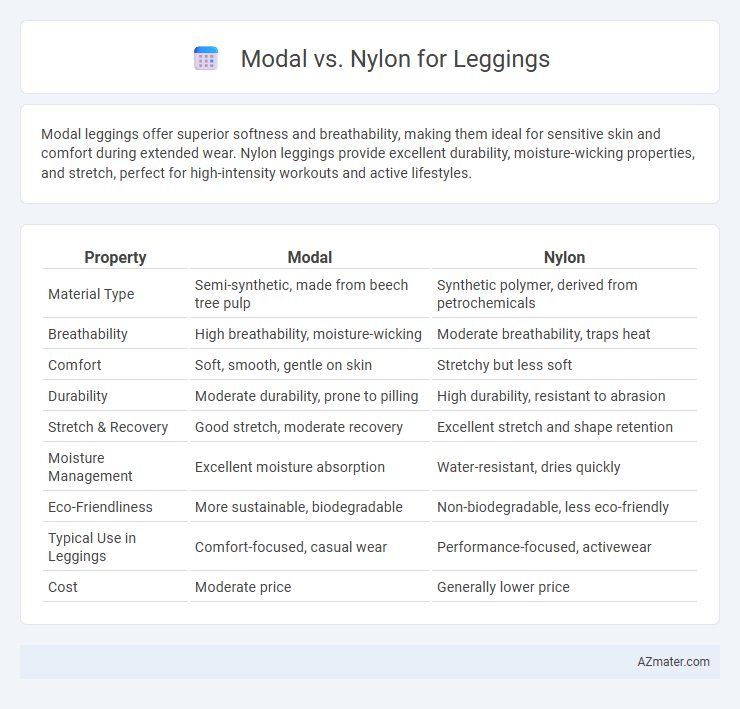Modal leggings offer superior softness and breathability, making them ideal for sensitive skin and comfort during extended wear. Nylon leggings provide excellent durability, moisture-wicking properties, and stretch, perfect for high-intensity workouts and active lifestyles.
Table of Comparison
| Property | Modal | Nylon |
|---|---|---|
| Material Type | Semi-synthetic, made from beech tree pulp | Synthetic polymer, derived from petrochemicals |
| Breathability | High breathability, moisture-wicking | Moderate breathability, traps heat |
| Comfort | Soft, smooth, gentle on skin | Stretchy but less soft |
| Durability | Moderate durability, prone to pilling | High durability, resistant to abrasion |
| Stretch & Recovery | Good stretch, moderate recovery | Excellent stretch and shape retention |
| Moisture Management | Excellent moisture absorption | Water-resistant, dries quickly |
| Eco-Friendliness | More sustainable, biodegradable | Non-biodegradable, less eco-friendly |
| Typical Use in Leggings | Comfort-focused, casual wear | Performance-focused, activewear |
| Cost | Moderate price | Generally lower price |
Introduction to Modal and Nylon Leggings
Modal leggings are crafted from a semi-synthetic fiber derived from beech tree pulp, offering superior softness, breathability, and moisture-wicking properties ideal for activewear and casual comfort. Nylon leggings, made from a durable synthetic polymer, provide excellent elasticity, abrasion resistance, and shape retention, making them perfect for high-performance workouts and long-lasting wear. Both materials combine comfort and functionality, with modal excelling in natural feel and nylon leading in strength and stretch.
Fabric Composition: Modal vs Nylon
Modal fabric, derived from beech tree pulp, is a semi-synthetic fiber known for its softness, breathability, and excellent moisture-wicking properties, making it ideal for comfortable leggings. Nylon, a fully synthetic polymer, offers superior durability, elasticity, and resistance to abrasion, often blended with spandex to enhance stretch and shape retention. Choosing between modal and nylon in leggings depends on the preference for natural softness and breathability versus high-performance durability and elasticity.
Comfort and Softness Comparison
Modal leggings provide superior softness and breathability due to their natural cellulose fiber origin, enhancing comfort during extended wear. Nylon leggings, while durable and moisture-wicking, often feel less soft and can cause a slightly synthetic sensation against the skin. Overall, modal fabric excels in comfort and gentle texture, making it ideal for those seeking a luxurious, soft legging experience.
Durability and Longevity of Each Material
Modal leggings offer moderate durability, known for their softness and breathability, but they may show wear such as pilling or thinning after frequent washing. Nylon leggings provide superior durability and longevity due to their high tensile strength and resistance to abrasion, making them ideal for intensive activities and extended use. Choosing nylon ensures leggings maintain shape and color retention over time, whereas modal prioritizes comfort with slightly less longevity.
Moisture-Wicking and Breathability Differences
Modal leggings feature superior moisture-wicking capabilities due to their natural cellulose fibers, which absorb sweat efficiently and release it quickly, keeping the skin dry during workouts. Nylon leggings excel in durability and stretch but tend to trap heat and moisture, making them less breathable than Modal. For athletes prioritizing breathability and moisture management, Modal leggings offer enhanced comfort by promoting airflow and rapid evaporation.
Stretch and Flexibility for Active Wear
Modal leggings offer superior softness and breathability but provide moderate stretch and flexibility suitable for low to medium-intensity activities. Nylon leggings excel in elasticity and durability, delivering excellent stretch and recovery, making them ideal for high-intensity workouts and active movement. Combining nylon with spandex enhances flexibility, moisture-wicking properties, and comfort during rigorous exercise or yoga sessions.
Eco-Friendliness and Sustainability Factors
Modal fabric, derived from beech tree pulp, offers a biodegradable and renewable option for leggings with a lower environmental impact due to less water and chemical use during production. Nylon, a synthetic polymer made from petrochemicals, typically involves energy-intensive manufacturing processes and is not biodegradable, raising concerns about microplastic pollution and long-term sustainability. Choosing modal leggings supports eco-friendliness through biodegradability and responsible sourcing, while nylon leggings pose challenges related to fossil fuel dependency and environmental persistence.
Care Instructions and Maintenance
Modal leggings require gentle washing in cold water to preserve their softness and prevent shrinking, while nylon leggings benefit from hand washing or machine washing on a delicate cycle to maintain elasticity and durability. Avoid using bleach or fabric softeners on both fabrics to extend their lifespan and keep the material intact. Air drying is recommended for modal and nylon leggings to prevent heat damage and preserve the fit and texture of the fabric.
Price Range and Value for Money
Modal leggings generally fall into a mid to high price range due to their softness and moisture-wicking properties, offering excellent value for money in terms of comfort and durability. Nylon leggings are typically more affordable and provide superior stretch and resilience, making them a budget-friendly option ideal for activewear with high elasticity needs. Choosing between Modal and Nylon leggings depends on prioritizing either luxurious feel and breathability or cost-efficiency and durable performance.
Which Legging Material Should You Choose?
Modal leggings offer exceptional softness and breathability due to their cellulose-based fibers, making them ideal for all-day comfort and moisture-wicking during workouts. Nylon leggings provide superior durability, excellent stretch, and resistance to abrasion, which is perfect for high-intensity activities and long-lasting wear. Choosing between modal and nylon depends on whether you prioritize comfort and softness (modal) or strength and performance (nylon) in your leggings.

Infographic: Modal vs Nylon for Legging
 azmater.com
azmater.com